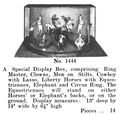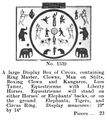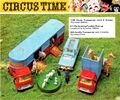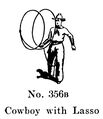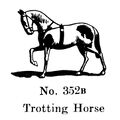Category:Circuses
1936: Circus train cars, Märklin, Lion in Cage and Circus Cash Office [image info]
1968: Corgi Toys "Circus Time" range [image info]
1970: Circus Time, Corgi [image info]
1970: Circus Time, Corgi [image info]
Makeup and Disguise, clown face [image info]
Circuses and circus-related toys.
The modern tradition of circuses is reckoned to start in England in the mid-Eighteenth-century, with the display of horseriding "tricks" in an indoor location with a circular area for the performance.
The display of "horse tricks" was then supplemented with theatre and street performers, such as jugglers and clowns, and the display of exotic animals, and as circuses grew larger, acrobatic troupes and wider ranges of exotic animals.
"The circus is a tiny closed-off arena of forgetfulness. For a space it enables us to lose ourselves,to dissolve in wonder and bliss, to be transported by mystery. We come out of it in a daze, saddened and horrified by the everyday face of the world."
— , Henry Miller,
The traditional circus became progressively less relevant though the late Twentieth Century, and was also damaged by an increasing public concern for the welfare of the performing animals. The prime example of a "modern", successful, Twenty-First Century circus, Cirque du Soleil, creates elaborate spectacles, often significantly above ground level, using just human performers and acrobats.
The ring
The use of a circular "ring" (rather than, say, a rectangular area) made it easier for a horserider to trot around the edge and be seen from all angles by the audience, and the use of a perfect circle meant that a trained horse could trot along at a fixed distance from the edge, freeing the rider from having to "steer". The circle also meant that a performer standing on a horse's back could lean inwards at a constant angle to compensate for centrifugal forces.
Philip Astley (1742-1814) decided on an ideal ring size of 42 feet in diameter, a size that has been used by most subsequent circus-type venues as the standard size. Standardisation meant that riders and horse-acrobats could lean inward at a known angle for a given speed, the way they'd practised doing their entire professional life, without needing to think about it. Riders that had started out working at Astley's venues and then set up their own competing attractions would want to use the same diameter ring as Astley, the next generation that had trained and trained their horses at those venues and then moved on would have again wanted to use the same size, and so on. Since 42 feet did actually work pretty well, and there was no obvious reason to change it, the size "stuck".
This need for standardisation meant that the larger circus tents with larger display areas tended to use multiple rings rather than a single larger ring, which would have meant the horses and riders having to re-learn their tricks, and a greater chance of something going wrong.
Circus history
- Philip Astley works as a horse-trainer during the Seven Years War, and his imagination is captured by European "trick-riders" including Jacob Bates, who use circular arenas
- 1768 – Philip Astley opens a riding school in central London, and shows off his trick riding skills in the afternoons.
- 1770 – Astley hires theatre performers such as jugglers and clowns to make his performances more interesting.
- 1782 – Astley opens the Amphithéâtre Anglais, in Paris
- 1782 – Charles Hughes opens the Royal Circus and Equestrian Philharmonic Academy, in London
- 1793 – John Bill Ricketts opens the first circus in the US, in Philadelphia.
- 1797 – Philip Lailson opens a circus in Mexico.
- 1820s – - the number of circuses in the US booms.
- 1825 – Joshuah Purdy Brown acquires a young elephant and uses it as the basis of a travelling menagerie, using a canvas tent for the first time.
The use of canvas helps transform the travelling circus, which no longer has to book a suitable indoor venue at each location it visits, and can simply set up in a large field.
- 1835 – creation of the Zoological Institute, a cartel of New-York-based farmers and menagerie owners, with three associated circuses. At the time, the ZI appears to be the future of American circus, but it is wiped out by the financial "Panic of 1837", leaving the field open again for independent circuses to ascend to dominance.
- Showman P. T. Barnum and circus logistics genius William Cameron Coup combine forces to produce Barnum's circus.
In the US, travelling circuses becomes more and more extravagant, and the concept of a circus train appears.
- Ocean-going steamships allow Cooper, Bailey & Co.’s Great International Allied Show to start a two-year tour in San Francisco and finish in New York via the coasts of North and South America via Australia and New Zealand.
- The idea of the circus parade becomes common, where the arrival of a circus in town is accompanied by a parade through the centre of the town to make absolutely sure that none of the locals can fail to know about it.
- Barnum and Bailey's competing circus businesses merge to produce a mega-circus with multiple rings and multiple tents.
- The Barnum and Bailey circus visits Europe, and while away, the circus family the Ringling Brothers make the best of B&B's absence.
- 1907 – Ringling Brothers take over Barnum and Bailey circus, which has been doing badly since the death of Barnum and other key founders.
A few decades into the Twentieth Century, the circus had started to lose its grip on the public. While at least one circus had a sideshow of "peoples of the world", the public appetite to see what was going on on the rest of the planet was partly satiated by a series of temporary exhibitions and World Fairs, where the public could see temporary themed exhibitions and pavilions whose sprawl was far larger than a visiting circus could compete with, and which could show examples of how human life was being rapidly changed by advancing technology rather than lions and acrobats.
While circuses remained popular through the first half of the Twentieth Century, the appearance and popularisation of radio meant that people had other ways of feeling a live connection to the outside world, and cinema (ironically, introduced to many Americans for the first time as a novelty sideshow gimmick in circuses) provided grand visual escapist spectacles, especially with the rise of Hollywood.
After World War Two, television was well enough established to be able to offer a wide range of entertainment inside people's own homes, and the circus (like the genre of "music-hall") largely died away, finding it difficult to compete with the force of radio, TV, vinyl records and cinema combined. In the Nineteenth Century, if you wanted to know what a lion looked like, your only options were a book or a zoo or a circus. By the mid-Twentieth Century, anyone who wanted to see and hear a roaring lion had already seen one in the credits of the last MGM movie they'd seen.
See also:
Links
- The circus comes to the Circus (news.bbc.co.uk)
- Short History of the Circus, by Dominique Jando (circopedia.org)
- Circus History and Origins - From the First Circus (historyofcircus.com)
- National Fairground and Circus Archive Brief History of Circus ()sheffield.ac.uk
- Cooper, Bailey & Co.'s Great International, 1877 (circushistory.org)
post ww2:
Subcategories
This category has the following 3 subcategories, out of 3 total.
Pages in category ‘Circuses’
The following 17 pages are in this category, out of 17 total.
C
Media in category ‘Circuses’
The following 32 files are in this category, out of 32 total.
- Britains Circus Set 1442 6pc (BritCat 1940).jpg 1,505 × 929; 146 KB
- Britains Circus Set 1443 10pc (BritCat 1940).jpg 1,533 × 1,200; 228 KB
- Britains Circus Set 1444 14pc (BritCat 1940).jpg 1,522 × 1,456; 231 KB
- Britains Circus Set 1539 23pc (BritCat 1940).jpg 1,509 × 1,689; 299 KB
- Britains Mammoth Circus, retailers showcard No9 (Britains 1958-01).jpg 1,800 × 536; 248 KB
- Britains Mammoth Circus, showcard 10 (BritCat 1940).jpg 1,533 × 503; 141 KB
- Circus Animals Pack, Harbutts Plasticine (Hobbies 1966).jpg 1,596 × 1,497; 890 KB
- Circus Cashier Car, Märklin 1983-C (MarklinCat 1936).jpg 953 × 719; 349 KB
- Circus Lion Cage Car, Märklin 1983-T (MarklinCat 1936).jpg 971 × 755; 351 KB
- Circus Time, Chipperfields Circus, Corgi Toys (CorgiCat 1968).jpg 2,000 × 1,530; 694 KB
- Circus Time, Chipperfields Circus, page22 (CorgiCat 1970).jpg 1,600 × 1,330; 1.87 MB
- Circus Time, Chipperfields Circus, page23 (CorgiCat 1970).jpg 1,600 × 1,330; 1.62 MB
- Circus Wagon (LincolnLogs 2L).jpg 1,200 × 1,080; 350 KB
- Clown (Boxing), Britains Circus 447 (BritCat 1940).jpg 560 × 784; 37 KB
- Clown with Hoop, Britains Circus 354 (BritCat 1940).jpg 645 × 997; 64 KB
- Clown, Standing, Britains Circus 358 (BritCat 1940).jpg 628 × 809; 51 KB
- Cowboy with Lasso, Britains Circus 356 (BritCat 1940).jpg 701 × 813; 47 KB
- Elephant (Performing, without Tub), Britains Circus 450 (BritCat 1940).jpg 801 × 1,109; 78 KB
- Elephant, Britains Circus 359 (BritCat 1940).jpg 684 × 845; 65 KB
- Elephant, circus floor toy (CWS).jpg 800 × 597; 302 KB
- Equestrienne, Britains Circus 355 (BritCat 1940).jpg 601 × 797; 42 KB
- Horse (Prancing), Britains Circus 351 (BritCat 1940).jpg 589 × 977; 48 KB
- Horse (Trotting), Britains Circus 352 (BritCat 1940).jpg 721 × 721; 49 KB
- Kangaroo (Boxing), Britains Circus 451 (BritCat 1940).jpg 665 × 857; 46 KB
- Lion Tamer, Britains Circus 448 (BritCat 1940).jpg 500 × 941; 38 KB
- Makeup and Disguise, front cover (BGL Actors Outfit).jpg 1,113 × 1,600; 417 KB
- Man on Stilits, Britains Circus 353 (BritCat 1940).jpg 517 × 969; 38 KB
- Ring Master, Britains Circus 357 (BritCat 1940).jpg 497 × 753; 35 KB
- Tiger (Performing), Britains Circus 447 (BritCat 1940).jpg 652 × 617; 43 KB
- Tub, Britains Circus 446 (BritCat 1940).jpg 449 × 478; 25 KB







